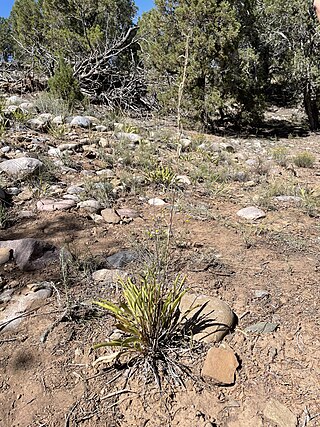
Bellis is a genus of flowering plants in the family Asteraceae.

Gaillardia pulchella is a North American species of short-lived perennial or annual flowering plants in the sunflower family.

Cornus canadensis is a species of flowering plant in the dogwood family Cornaceae, native to eastern Asia and North America. Common names include Canadian dwarf cornel, Canadian bunchberry, quatre-temps, crackerberry, and creeping dogwood. Unlike its relatives, which are for the most part substantial trees and shrubs, C. canadensis is a creeping, rhizomatous perennial growing to about 20 centimetres tall.

Banksia grossa is a species of shrub in the family Proteaceae and is endemic to Southwest Australia. It is one of fourteen species of banksia of the series Abietinae, all of which bear predominantly cylindrical or oval inflorescences. Collected in 1965, it was first formally described in 1981 by Alex George. Its thick leaves and large seeds distinguish it from other members of the Abietinae, and are the basis of its species name.

Bellis annua, the annual daisy, is a small daisy species native to Mediterranean countries eastward to Iran.

Gutierrezia microcephala is a species of flowering plant in the family Asteraceae known by the common names sticky snakeweed, threadleaf snakeweed, threadleaf broomweed, and smallhead snakeweed. It is a subshrub native to the southwestern United States and northern Mexico, and can be found in arid grassland and desert sand dune habitats. It can be toxic to livestock in large quantities, due to the presence of saponins and high concentrations of selenium.

Pimelea microcephala, commonly known as mallee rice-flower or shrubby rice-flower is a species of flowering plant in the family Thymelaeaceae and is endemic to mainland Australia. It is an erect shrub with compact heads of male or female, white to yellow or greenish flowers on separate plants, the heads surrounded by 2 or 4 leaf-like involucral bracts.

Acourtia microcephala is a species of flowering plant in the family Asteraceae known by the common name sacapellote. It is native to southern California and Baja California, where it grows in woodland and chaparral, especially in the coastal mountain ranges.
Isocarpha (pearlhead) is a genus of flowering plants in the family Asteraceae. They are native to Mexico, Central America, the West Indies, and northern South America, with the range of one species extending north into the United States.

Gaillardia pinnatifida, the Hopi blanketflower or red dome blanketflower, is a perennial plant in the family Asteraceae found in northern Mexico and in the south-central and southwestern United States.
Tagetes stenophylla is a Mexican species of marigold in the family Asteraceae. It has been found in the States of Guerrero, Jalisco, Morelos, Michoacán, and México State in western and central Mexico.

Grindelia adenodonta, the Lonestar gumweed, is a species of flowering plants in the family Asteraceae.
Grindelia microcephala, the littlehead gumweed, is a North American species of flowering plants in the family Asteraceae. It is native to the south-central United States, having been found only in the state of Texas.

Helianthella microcephala, common name purpledisk helianthella, is a North American plant species in the family Asteraceae. It grows in the southwestern United States, in the states of Arizona, New Mexico, Colorado, and Utah.
Hypochaeris microcephala, the smallhead cat's ear, is a species of plants in the tribe Cichorieae within the family Asteraceae. It is native to South America and naturalized in parts of North America.
Isocarpha oppositifolia, the Rio Grande pearlhead, is a New World species of plants in the family Asteraceae. It is widely distributed in eastern and southern Mexico, Central America, the West Indies, and northern South America. The range extends northward, just barely crossing to the north side of the Río Grande in the two southernmost counties in Texas.
Isocarpha atriplicifolia is a New World species of plants in the family Asteraceae. It is widely distributed in southern Mexico, Central America, the West Indies, and northern South America.
Isocarpha megacephala is a New World species of plants in the family Asteraceae. It has been found only in northeastern Brazil.
Isocarpha fistulosa is a New World species of plants in the family Asteraceae. It has been found only in Peru and Ecuador.
Iva microcephala, the piedmont marsh elder, is a North American species of flowering plants in the family Asteraceae. It grows in the southeastern United States in Alabama, Florida, Georgia, and the Carolinas.










